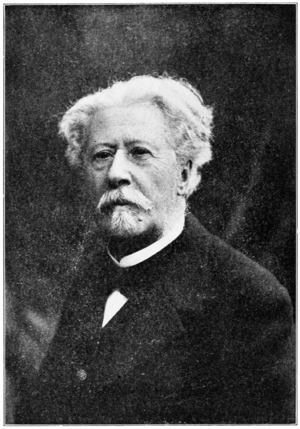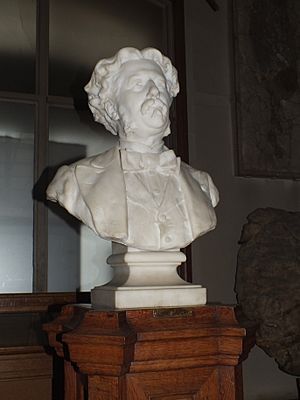Jean Albert Gaudry facts for kids
Quick facts for kids
Jean Albert Gaudry
|
|
|---|---|
 |
|
| Born | 16 September 1827 St Germain-en-Laye, France
|
| Died | 27 November 1908 (aged 81) |
| Occupation |
|
| Awards | Wollaston Medal (1884) |
Jean Albert Gaudry (born September 16, 1827 – died November 27, 1908) was a French scientist. He studied rocks and the history of Earth (a geologist). He also studied ancient life forms like fossils (a palaeontologist). He was born in St Germain-en-Laye, France. Gaudry believed that the idea of evolution was part of a divine plan guided by God.
Contents
Gaudry's Scientific Journey
When he was 25, Gaudry explored Cyprus and Greece. He lived in Greece from 1855 to 1860. During this time, he found many amazing fossils of animals with backbones (called vertebrata) at a place called Pikermi.
These fossils were from the Miocene period, which was millions of years ago. The animals he found were like a mix of types seen in Europe, Asia, and Africa. He also wrote about the geology of Cyprus.
In 1853, Gaudry became an assistant to Alcide Dessalines d'Orbigny. Orbigny was the first person to hold a special job studying fossils at the natural history museum in Paris. In 1872, Gaudry took over this important role.
He became a member of the French Academy of Sciences in 1882. Later, in 1895, he was chosen as a foreign member of the Royal Society of London. In 1900, he led a big meeting of geologists in Paris. He also became a member of the Royal Swedish Academy of Sciences that same year.
Gaudry was well-known for his work on fossil mammals. His studies helped support the idea of evolution. He also looked at other topics. For example, he described an ancient animal called Haptodus baylei. At the time, he wasn't sure what kind of animal it was. Today, we know it was a type of synapsid, which are ancestors of mammals.
Professor Huxley, a famous scientist, said that Gaudry's discoveries were like finding a new country. This country was full of new forms of life, just like Brazil or South America once were to Europeans.
Gaudry's Ideas on Evolution

Gaudry was one of the first scientists to draw a "family tree" for fossil animals in 1866. This tree showed how different ancient life forms might be related.
Gaudry believed in theistic evolution. This means he thought evolution happened, but it was guided by God. In his book Essai de paléontologie philosophique (1896), he wrote that evolution was part of a divine plan.
Charles Darwin, the famous scientist who developed the theory of evolution, mentioned Gaudry's fossil research. Darwin included Gaudry's findings from Pikermi in later editions of his books, On Origin of Species and The Descent of Man. Another famous scientist, Alfred Russel Wallace, also praised Gaudry's work.
Gaudry found and put together several new mammal species that seemed to be "in-between" forms. He saw these as proof of evolution. However, he disagreed with Darwin on one key point. Gaudry believed these changes were part of God's plan, not just random chance.
Because of his strong religious beliefs, Gaudry did not agree with the idea of natural selection. This is Darwin's idea that living things compete to survive and reproduce. Gaudry felt that evolution showed a unity in nature that came from God's work.
Gaudry's Thoughts on Creation
Gaudry once wrote about his views on how life changed over time: "If we agree that living things have slowly changed, we can think of them like soft clay. An artist has shaped this clay over millions of years, making it longer here, wider or smaller there. Just like a sculptor creates many forms from clay, following their genius. But we will not doubt that the artist was the Creator himself. This is because each change has shown a reflection of His endless beauty."
See also
 In Spanish: Jean Albert Gaudry para niños
In Spanish: Jean Albert Gaudry para niños

